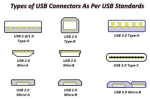Posted only a month ago on Reddit:
I have recommended Lenovo laptops for a while now. I have a Legion 7 and a ThinkPad T14 and I really like them, although the Legion has one of three USB-C ports that randomly disconnects frequently, which I will eventually have repaired under warranty prior to selling it.
I used to recommend used ThinkPads from eBay for those that wanted a very nice computer for a great price, but not anymore due to the huge issue with failing USB-C charging ports. Several of my client's used ThinkPads have had their USB-C power ports fail. At first, it seemed like only some E models were affected. I have a T14 myself and the USB-C port has worked great for the nearly 1 year I've had the laptop. Last month, I had a guy get a T15 and the USB-C port is very wiggly and died less than a month after he got it. Luckily, the second USB-C port works and charges the laptop and it has a 1-year warranty through Allstate. It's a certified eBay refurb.
After seeing so many failed USB-C ports and finding the above Reddit thread, I will no longer recommend USB-C powered Lenovo laptops. It sucks bad that they are soldered to the mobo. The charging ports should be built extra tough or be connected to the mobo by a cable for super easy replacement.
Does this mean Lenovo quality has went downhill? Are other companies having this issue as well? Should I totally avoid all USB-C powered laptops with the exception of MacBooks?
I was a big fan of Lenovo until I learned that they are a Chinese company. It seems like most stuff that's made AND designed in China are junk or inferior to products designed in other nations. I'm a big fan of stuff designed in the USA, Japan, Australia, and European countries such as Germany.
I wonder if there still exists newer Windows 11-compatible ThinkPads that use the old rectangular power port. Perhaps from now on I will recommend Dell business-class laptops instead. I just wish that they had the super sweet keyboards that the ThinkPads use. Hell, I wish all laptops used ThinkPad keyboards. They are dam awesome.
I have recommended Lenovo laptops for a while now. I have a Legion 7 and a ThinkPad T14 and I really like them, although the Legion has one of three USB-C ports that randomly disconnects frequently, which I will eventually have repaired under warranty prior to selling it.
I used to recommend used ThinkPads from eBay for those that wanted a very nice computer for a great price, but not anymore due to the huge issue with failing USB-C charging ports. Several of my client's used ThinkPads have had their USB-C power ports fail. At first, it seemed like only some E models were affected. I have a T14 myself and the USB-C port has worked great for the nearly 1 year I've had the laptop. Last month, I had a guy get a T15 and the USB-C port is very wiggly and died less than a month after he got it. Luckily, the second USB-C port works and charges the laptop and it has a 1-year warranty through Allstate. It's a certified eBay refurb.
After seeing so many failed USB-C ports and finding the above Reddit thread, I will no longer recommend USB-C powered Lenovo laptops. It sucks bad that they are soldered to the mobo. The charging ports should be built extra tough or be connected to the mobo by a cable for super easy replacement.
Does this mean Lenovo quality has went downhill? Are other companies having this issue as well? Should I totally avoid all USB-C powered laptops with the exception of MacBooks?
I was a big fan of Lenovo until I learned that they are a Chinese company. It seems like most stuff that's made AND designed in China are junk or inferior to products designed in other nations. I'm a big fan of stuff designed in the USA, Japan, Australia, and European countries such as Germany.
I wonder if there still exists newer Windows 11-compatible ThinkPads that use the old rectangular power port. Perhaps from now on I will recommend Dell business-class laptops instead. I just wish that they had the super sweet keyboards that the ThinkPads use. Hell, I wish all laptops used ThinkPad keyboards. They are dam awesome.


